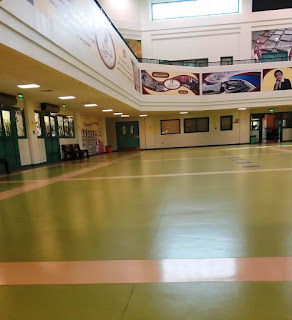How old are you? I'm seven.
Your chest is red.
Your hair is yellow.
What's your name?
You're old.
Do you Salat? (Palms down, praying motions.)
Why don't you Salat? (More praying motions.)
Little girls circle me, a sea of dark eyes, dark hair and gray, ankle length, vest-style uniforms and crisp white shirts. Mona, Abeer, Sheikha, Loobya. They run away only to come rushing back, arms open, smiles wide. "Salaam alaykum wo rahmahu allahi wo barakatu!"
My Arabic is not quick enough to respond (or request clarification) before they've moved on to the next subject. They forgive me wholly, chattering on as though I were participating in the conversation. I absorb the sweet, embracing, curiosity-filled, wonder-love, adorable little girl-ness - and their Arabic.
There's a game involving hoops, stickers and lines of happy little girls in the bright interior play space. Windows high above filter dazzling Middle Eastern light into the area. Laughter echoes against tile floors. There are English and Arabic words painted on walls in cheerful primary colors. Pictures of the Emir and HH - and Dora the Explorer - surround us.
It's lunchtime for "Al Awwal C" (Grade 1C) at this Independent Primary Girls School in Doha, Qatar.
Doha's "Independent" schools are government funded, free for locals and approved others (GCC-nationality government employees, for example). The language of instruction is Arabic and boys and girls are taught at separate locations. Men teach boys, women teach girls. According to local news, women are no longer employed in any capacity at boys' independent schools. Men are not allowed inside girls' schools.
For months I've walked into schools like this one, hoping for a chance to "atakellam wo istama'" (speak and listen). I've met with principals, vice principals, administrators. Provided a copy of my passport and a letter of introduction from Fanar (where I'm a student). Called for appointments, waited in the lobby, gone away, returned, waited, waited and waited some more.
Schools (and homes) are hidden behind high concrete and stone walls for privacy reasons. On this day I drive through the 12-foot high exterior gate. A second barrier shields the school itself from the parking lot. A traditionally garbed father paces outside the interior gate while his traditionally dressed pre-pubescent son retrieves the man's young daughter. I step through the door in the inside wall, walk across the empty, flower lined courtyard to the paper covered entrance. A male security guard averts his eyes as he leaves a tray of tea beside the door.
Inside, I expect to be given another phone number. To wait, leave, come back, wait some more. Instead, I'm ushered through clear glass doors, beyond the backpack and cubby lined hallway. I'm introduced to lunch ladies, teachers, a social worker, administrators and helpers. I shake hands, give - and receive - traditional greetings, hug little girls, speak, listen and learn...in Arabic.
Inside this protected area adult women may choose to cover, uncover, wear abayas as jackets, loosen hijabs. Professional Middle Eastern women wear modest suits, skirts, pants, blazers, sweaters, saris, scarves, flats, heels, with or without makeup, hair clipped or unclipped. It is impolite to take photos of people here.
In a classroom I sit in a child sized chair amidst the most darling 7 year old girls ever.
As in any-primary-school-anywhere, little girls fidget, play with their hair, raise hands, talk-too-much, listen perfectly, scowl-frown, laugh-giggle. They are curious, enthusiastic, fun, funny, silly, serious, happy, sad, playful, sleepy, energetic, tearful, joyful. Hands up, hands down, stand up, sit down.
Teacher holds up a sign, says, "Shoof al biTaqah!" (Look at the card.)
The card says - in English: "Sit down."
Little girls read. Little girls sit.
First lesson is Arabic - in Doha, Khaleeji dialect speaking children learn Classical Arabic…just like me. I copy the dictation and a student reads to the class from my notebook.
Next is Math - today, students study subtraction using a fluent mix of Arabic and English. Fun cross curriculum activities involve beads, Dora the Explorer paper, markers and leggos.
Then English - there is music and a happy counting song. A smart board lights up and girls take a virtual trip to the "Beach-Beach-Beach" where they play with a balloon and a bat. There is laughter, singing, jumping, waving, walking, running. I am asked to lead the group in "Row-Row-Row-Your-Boat."
Later, 7 year old Mona presses her palms together, thumbs up, fingers forward and says to me:
iftah issundooq (open the box)
I press her palms open.
akl ittoofah (eat the apple)
I take the invisible fruit from her palm and pretend-eat it.
ghasl ishahr (wash your hair)
I rub apple-y hands over my hair.
(words I don't understand result in exuberant, belly-gripping, glee-filled hilarity)
En sha allah, I'll be allowed to return to this joyful place for more speaking, listening and learning. I need to know the punch line to Mona's story!




6 comments:
OMIGOSH! Sounds like fun! Little girls really are the same everywhere, aren't they? -AK
The same but different. And the difference of each is part of what makes them so sweet, and incredible!
Will we know it when you, Cindi, know the punch line of Mona's story?
Absolutely - they welcomed me with arms wide open. :)
They were so interested and openly curious. I need to improve my Arabic!!
En sha allah wo tab'an wo doona shakkin! (God willing, of course, without a doubt!) :) eeThan...(IF...)
Post a Comment